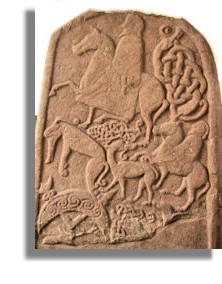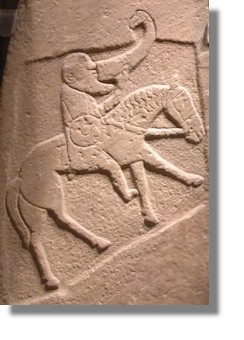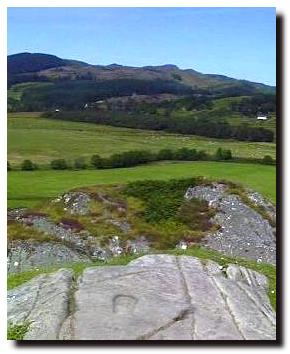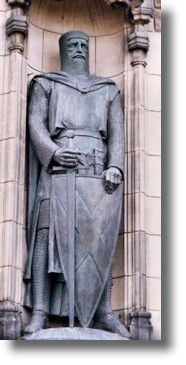
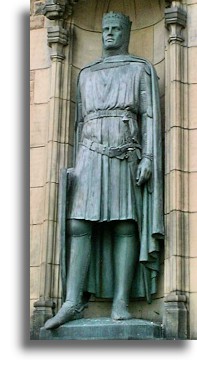
Scots History to 1400
By Michael Lynch
This is a section from the book "Scotland: a New History" by Michael Lynch which covers Scottish history from the earliest times to the present. There is an Index page of all the sections of the book up to the end of the 14th century which have been added to Rampant Scotland. The pages were previously part of the "Scottish Radiance" Web site.
Pictish Kings and Dalriada
Pictish kings
Three points of reference may help in this search for the nature of the Pictish kingdom. The rediscovery of the Picts as a Celtic people has encouraged closer comparison with practices in contemporary Ireland. Oddly, however, there has been little attempt to place the Picts in the context in which Roman observers must have seen them, of other hostile barbarian tribes on the mainland of western Europe such as the Franks or Goths. The first benchmark rests, however, in Scotland itself. Recent research in Scottish medieval kingship has taught us not to think in terms of its consolidation as the story of the steadily growing power of kings who ruled and to whom subjects automatically rendered obedience. Power was highly devolved, even as late as the sixteenth century; kings may have been formidable and ruthless men, but they relied on the power of their great nobles to extend their writ into the far flung corners of the realm. Pictish kingship should not be judged by impossible standards which few if any kings before James VI would have been likely to have met. Medieval kingship was highly personalised and informal. Pictish kingship was certainly no more than these things and probably a good deal less; early kings cannot be expected to have been administrators or autocrats. They were warlords, whose authority was expressed and acknowledged largely in the receiving of tribute, and of whom were expected military successes and the acquisition of prestige goods, by war, plunder or treaty.
Yet these Pictish warlords had, in some respects, more power than the medieval kings who followed them. It is clear from the one account that exists outlining the social and military structure of early warrior society, the Dalriadic History of the Men of Scotland, or Senchus fer nAlban, that a surprisingly comprehensive fiscal system underpinned the rationale of that society, each of the districts within the kingdom of Dalriada was assessed in terms of the number of its houses. Each house, it seems likely, was treated as a unit on which rent or tribute was payable, to nobles or kings. In addition, military service was also due and it is likely that a far higher proportion of society was mobilised for war before 1000 than after. It is also not surprising to find that in a terrain where most communication was by sea it was called 'galley service'. The Senchus was, in part, a muster list for a war fleet. Such details are not available for the Pictish kingdoms but it would be surprising if similar arrangements had not existed there too. For it is certain that Pictish kings formulas of custom or law. Kings survived by being strong; they succeeded by representing the strongest of the segments of the royal family.
Kings and kingship: the example of Dalriada
Carved Footprint on Rock at Fort Dunadd,
Kilmartin, where Dalriada Kings Were Crowned
But what was a king?. In Ireland, there were three types of king. The rí or rí túaithe was king of a tribe or petty kingdom; the ruirí or 'great king' was, as well as being a tribal king, the overlord of a number of other tribes and tribal kings. And above all of these was the rí ruirech, 'king of overkings'. Until the tenth or eleventh centuries, it is likely that counterparts of each of these grades of kings existed in Scotland. It may be easier to grasp the analogy in an account of the kings of a smaller kingdom, that of Dalriada. The Scots of Dalriada, who had begun to migrate to south-west Argyll from modern day Antrim sometime before their king, Fergus Mór, arrived c.500, were never a single gens, although all for long owed allegiance to him and his successors. From the beginning, the Dalriadic Scots were divided into three or more tribes, each with its rí and its own territory: the Cenél nÓengusa ('kindred of Óengus') occupied the island of Islay; the Cenél Loairn ('kindred of Loarn') held Colonsay as well as present-day Lorne and the northern frontier against the Picts; and the Cenél nGabráin ('kindred of Gabran'), who held the overlordship of the Scots, occupied Kintyre and the territories and islands fringing on the territory of the Britons of Strathclyde, modern-day Cowal, Bute and Arran. The relative importance of each of the three tribes is confirmed by the survey in the Senchus outlining the manpower each could produce: Cenél nGabráin had 560 houses or clients and could muster some 800 men; both Cenél Loairn and Cenél nÓengusa, which had 420 and 430 houses, could probably raise 600 men apiece.As the most strategically placed as well as having the greatest available manpower, the Cenél nGabráin enjoyed undisputed status as ruirí of the Scots of Dalriada throughout the sixth century and for much of the seventh. Their status could not have been other than greatly enhanced when Aedán mac Gabráin, great grandson of Fergus Mór, was ordained as overking of Dalriada in 573 by Columba, himself son of a royal house, on the explicit instructions, it was said, of an angel from Heaven; the novel overlaying of Christian imagery on the much older rite of inauguration of kings must have conveyed a potent extra symbolism. True to type, Aedán set out to prove himself a great warlord: the poem known as Berchan's Prophecy claims that he fought the Picts for thirteen years without a break. It is known that he waged an apparently successful campaign as far away as Orkney; his warriors certainly penetrated eastwards along the valley of the Forth, drawn no doubt by the crumbling power of the Gododdin kings based on Edinburgh's castle rock. But his ambitious expeditions led to defeats inflicted by the Picts somewhere in Angus and the Mearns and by the Angles of Northumbria in 603 at Degsastán, which has never been satisfactorily identified but was certainly somewhere within Northumbrian territory.
A series of further defeats, in Ireland as well as Pictland, inflicted on Aedán's grandson, Domnall Brec, who was killed in battle with Owain, King of Strathclyde, at Strathcarron in 642, not only ended a period of Dalriadic expansionism but also promoted the kingdom of Strathclyde as the major alternative seat of power in northern Britain. It was almost certainly a direct result of the military failures of successive kings of Cenél nGabráin that their hold on the overkingship of Dalriada formulas of custom or law. Kings survived by being strong; they succeeded by representing the strongest of the segments of the royal family.
Return to Index of Scots History to 1400
